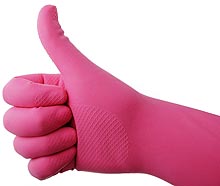| Home A B C D E F G H I J K L M N O P Q R S T U V W X Y Z |
|
Home |
Broken Nails: Treatment and Prevention Tips
We use them as makeshift screwdrivers or pliers. We drown them in dishwater and coat them with chemicals. No wonder our nails so easily break. Everything from a dry climate to constant immersion in hot water can cause nails to peel, split, and crack. And the pain can be considerable, especially if the nail splits to the quick. Here are some tips you can consider to help you to speed your healing process and for fast pain-relief. Clip broken nails quickly. If you break a nail, cut it as short as you can, this will keep the break from extending farther down your nail. 
Bandage the break...maybe. If your nail is torn and raw, apply an antibiotic ointment to help prevent infection, then cover the nail with a bandage. No need to bandage a less-serious split. A bandage will hold in heat and moisture, which can be detrimental. Clip nails correctly. Cut your nails straight across. Rounding the edges can cause an ingrown nail. Don gloves. When you are doing household chores, wear heavy cotton gloves for dry work such as gardening and vinyl gloves with cotton gloves underneath for wet work such as washing dishes. Your hands will sweat under the vinyl, and the cotton gloves will absorb the sweat. Use an ocean of lotion. Massage your nails with plain petroleum jelly or a hand cream that contains 10 percent urea. Trapping the moisture within the nails will help make them less brittle. Ration the nail polish remover. Touch up chipped polish instead of removing it completely. The reason? Nail polish remover contains strong solvents that can make nails bone-dry, leaving them vulnerable to splits and cracks. Try biotin. The vitamin biotin, available at drugstores and health food stores, has shown to strengthen nails. It is recommended taking 2.5 milligrams of biotin a day. But do not expect overnight improvement. It may take six months to see results. A nail that is broken seldom requires medical attention. But a nail that is injured by a slamming car door, for example can be serious. You should see a doctor if you develop symptoms of infection, such as swelling, a fever, or the formation of pus, or if your nail is extremely painful. If there is a lot of swelling or pain, you could have a broken bone, but not a broken nail. Also consult a doctor if you see blood under your nail. Go to the emergency room within an hour to release the pressure beneath the nail. If the pressure is not released, it can damage the nail root. But do not be alarmed if your nail turns black. It probably looks worse than it is. Raymond Lee Geok Seng is one of the foremost experts in the health and fitness industry and is a writer specializing in body health, muscle development and dieting. He has spent countless of time and efforts conducting research and share his insightful and powerful secrets to benefit men and women all over the world. He is currently the author of the latest edition of "Neck Exercises and Workouts." Visit http://www.bodyfixes.com for more information. |
||
|
|
||
|
Glossary References Links Contact
|